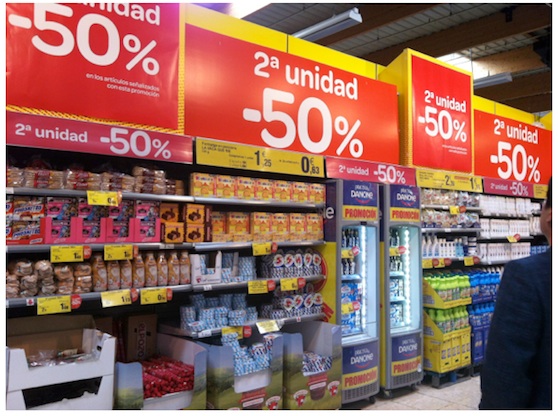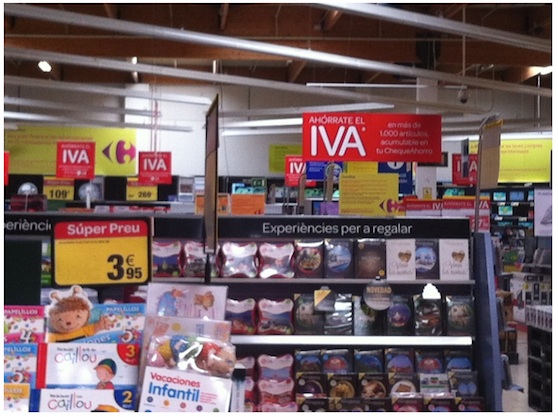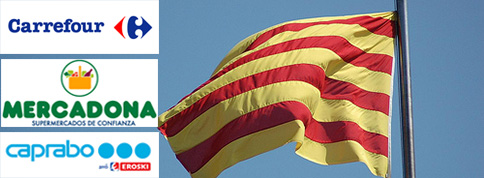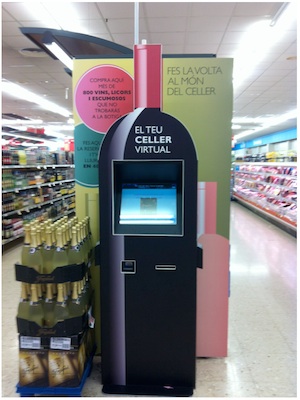I recently returned from a relatively rare business trip to Barcelona, Spain. Excited to be back in the market after a few years, I persuaded my client to take me on a tour of nearby stores. Predictably, of course Carrefour was on the list of stores we would go to, but so were Eroski’s Spanish subsidiary Caprabo and Spain’s own Mercadona. I was particularly keen to understand whether Spain’s economic woes had provoked any major retail innovations, and here’s what I found:
Discounters don’t have to be ‘cheap’
Think about hard discounters like Aldi and Lidl and immediately images of down-market stores, stocked with no-name brands and slim pickings in fresh foods come to mind. Not so in Mercadona, Spain’s home-grown answer to Germany’s upstarts. Mercadona is no competitor to Whole Foods BUT a lot of thought has gone into the in-store environment and there is a clear focus on quality (sorry no photos here – I was under strict instructions!). This is most obvious in fresh foods, but interestingly also in home and personal care, where the chain has invested heavily in building own-label products that perform ‘better’ than the branded alternative. I’ told that to drive this, promoters work in stores to discuss the benefits of Mercadona’s range with shoppers directly. Indeed even my die-hard foodie guide told me he was happy to buy floor cleaner and laundry powder here, whilst spending the savings on high quality organic produce at the local market. This interests me as stores like Mercadona are creating an interesting new trend to split purchases across channels, which leads shoppers to cherry pick prices on more commoditized categories, whilst seeking out higher end offers for life’s little luxuries.
Online in-store
Spain has its fair share of online operators and these are increasingly popular in larger cities, but what grabbed my attention in Caprabo’s well-stocked wine section was this booth next to the main wine aisle.
Here shoppers are able to order wines that aren’t available in-store for delivery or pick-up. You can search by origin and variety on a well-structured touch-screen interface. We’ve seen this before in department stores like the UK’s Debenhams, but this is a relatively rare example of a grocery store exploiting the broad range it offers online in a small community store.
Price, price, price
Spain’s cash-strapped housewives are well served with discounted offers and like all the other markets I visit, retailers compete hard on price. It’ll be no surprise that Carrefour’s sole distinguishing mark is its price offer, at least if judged by the store I visited. But I did notice two particular differences in the way the Spanish affiliate communicates price, which contrast messaging in my neighborhood. The first was the use of a very clear messaging in the power aisle, where bright panels advertise buy two, get second at half price.

The second was a VAT-free rebate on over 1000 non-foods lines.

Both offers and their communication are not really new, but they do illustrate that the retailer has grasped that a sea of yellow labels does not good communication make. The clear -50% panels are clean, easy to comprehend and offer more compelling reasons to stop.
Capitalizing on changes at retail
I guess I would have been more excited if I’d have come away with some really new ideas from my trip (as well as a stock of Serrano Ham!) but I do think that the above reflects some global trends in grocery retailing, and for the manufacturer provokes three potential actions:
- Understand the changing roles of channels – if more shoppers are likely to split purchases, then different channels will play increasingly divergent roles for your brands – understanding these will help position your products more effectively in the future.
- Combine online and offline to extend the available range – many shoppers complain about lack of in-store availability; as grocers increasingly integrate online and offline, the opportunity to make wider ranges available in-store becomes more viable, even in the smallest outlets.
- Understand the role of price communication – much research suggests that shoppers respond more to the message of price than to the price itself. So, using clearer and more compelling price messages may deliver higher promotional off take. This is important as 70% of promotions lose money, mostly because they don’t create sufficient off take to deliver a payback. If better price communication is the secret then it’s time to embrace this.
Get in touch if you’d like to share your thoughts on retail innovations, or if you need advice on how to capitalize on the changes your retail customers are making.

